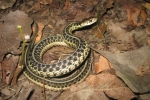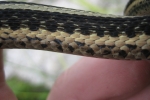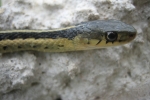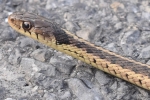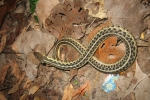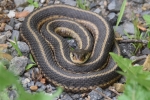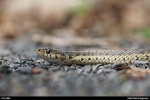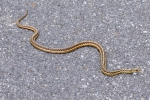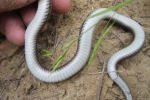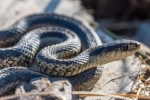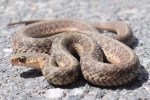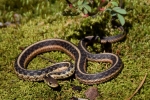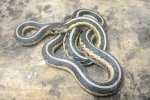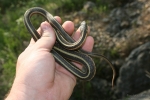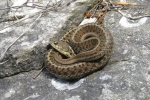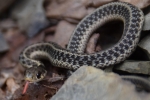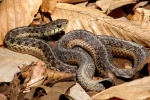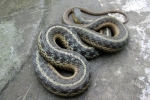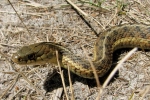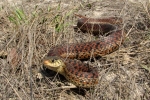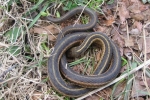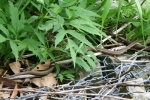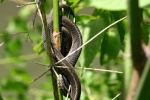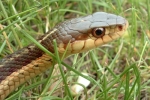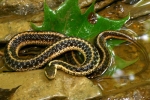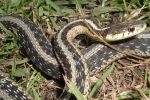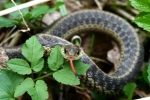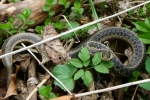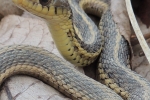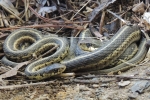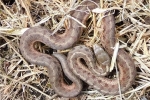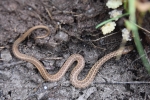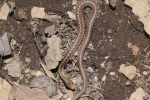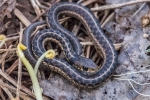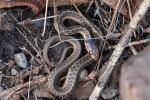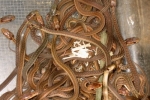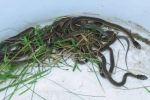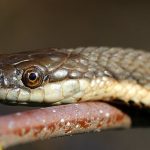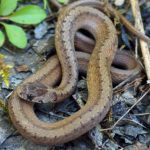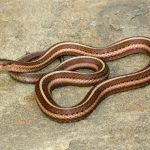Eastern Gartersnake
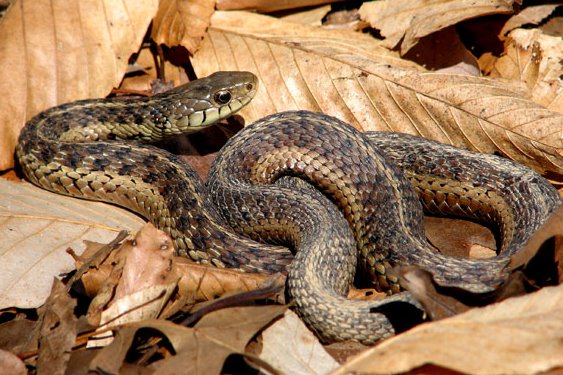
Scientific Name: Thamnophis sirtalis sirtalis
Size: 20-28 inches (50.8-71.1 cm) in length
Status: Abundant
Habitat:
Found in nearly all habitats from open talus slides, cultivated fields, open canopy deciduous and coniferous forest, swamps, marshes, and bogs to dry upland hillsides and/or human habitats. They are most often found around quarries, trash dumps, banks of ditches, canals, streams, rivers, ponds, or vacant lots, and may be found under logs, rocks, boards and other debris.
Description:
Common medium sized striped snake with highly variable coloration. The yellowish stripes are usually well defined, though the middorsal stripe may be absent in some populations. The background dorsal color may be green, olive to brown or black. Two rows of black or red (or both) spots may appear between the vertebral and lateral stripes on each side. The belly is plain whitish or cream colored with two rows of black spots.. The head is grey, olive, tan, brown, black or a reddish coloration. Scales are keeled and the anal plate single. Found in varied habitats but usually not far from water.
- The dorsal has a vertebral stripe (may be absent) and two lateral stripes.
- The stripes are white, cream, yellow, tan, brown or grey.
- The dorsal background varies from dark green, olive, olive brown, tan, black, grey to grey brown.
- Two rows of black or red (or both) spots may or may not appear between the vertebral and lateral stripes on each side.
- The ventrals are grey, green, ivory, cream or yellow with two rows of black spots. These ventral spots may be hidden by the overlapping ventrals.
- The head is grey, olive, tan, brown, black or a reddish coloration.
- The head coloration is similar to the dorsal background.
- The supralabials have dark bars.
- The throat is light colored.
- There are a few cases of melanistic individuals throughout PA.
- Medium- sized, fairly heavy-bodied species.
- The head is distinct from the body
- Dorsal scales are keeled.
- Similar to adults.
- 19 scale rows at midbody and anterior
- 17 scale rows at posterior
- 128-178 ventral scales
- 52-97 subcaudals scales | 2 rows of subcaudals
- 2 nasal scales
- 1 loreal scale
- 1 preocular scale
- 3 postoculars scales
- 1+2 temporal scales
- 7 supralabials
- 10 infralabials
- Anal plate is undivided


References:
- Hulse, C. and McCoy C. J. and Ellen Censky ,1998. Amphibians and Reptiles of Pennsylvania and the Northeast. 337-339pp.
- Ernst, Carl H. and Ernst, Evelyn M. ,2003. Snakes of the United States and Canada. 424-436pp.
- Jason Poston
- Bob Hamilton
- Wayne Fidler
- Sebastian Harris
- Don Becker (psychoticnature.com)
- Kyle Fawcett
- Kyle Loucks
- Bob Ferguson
Heads up!
Please contribute your observation of this and other herps to the Pennsylvania Amphibian and Reptile Survey. Your help is needed.
